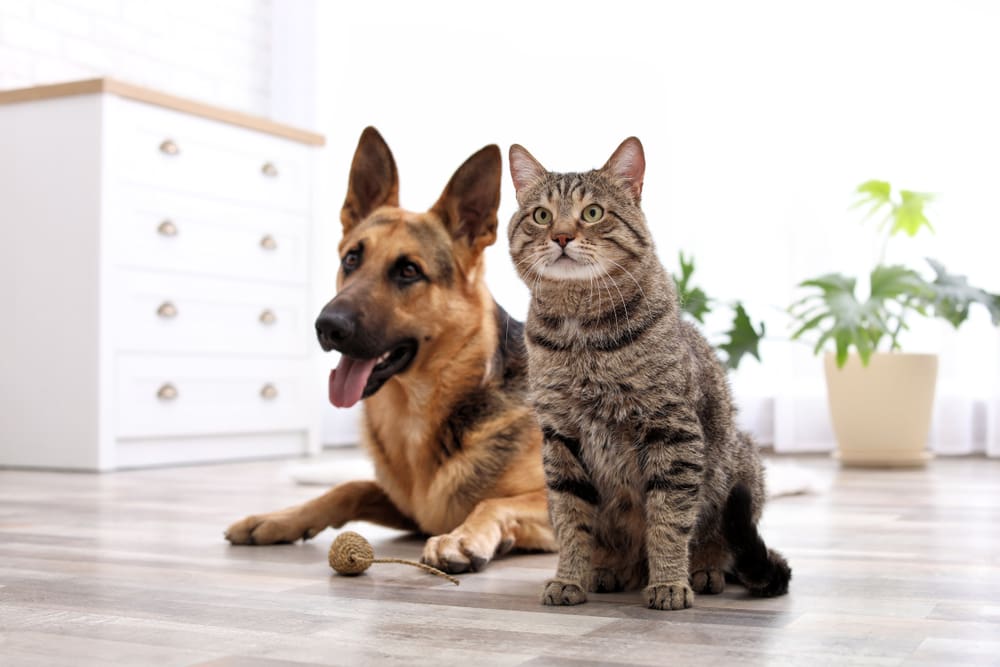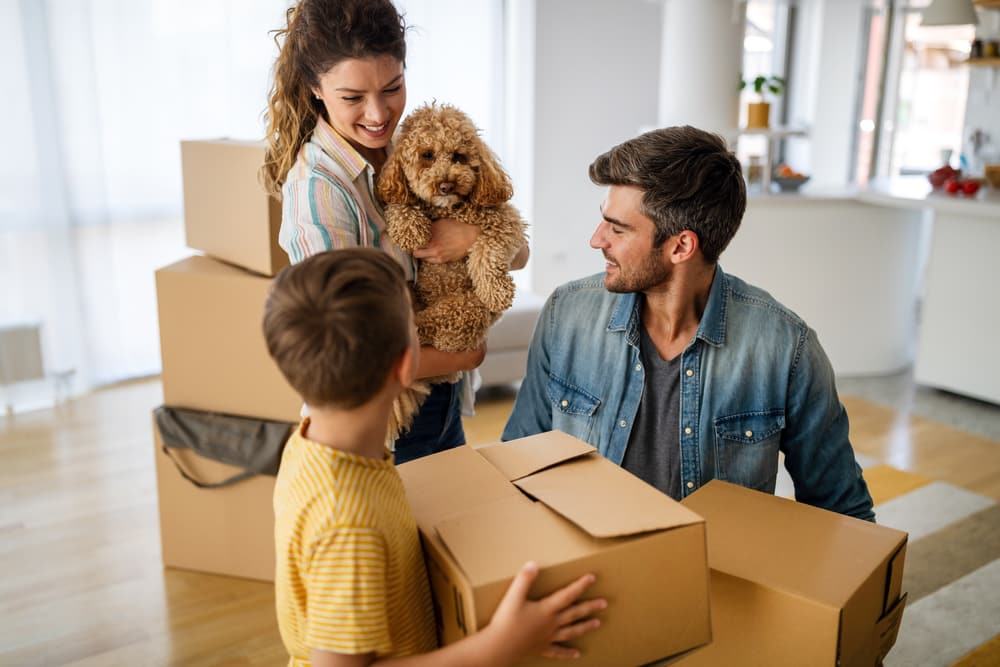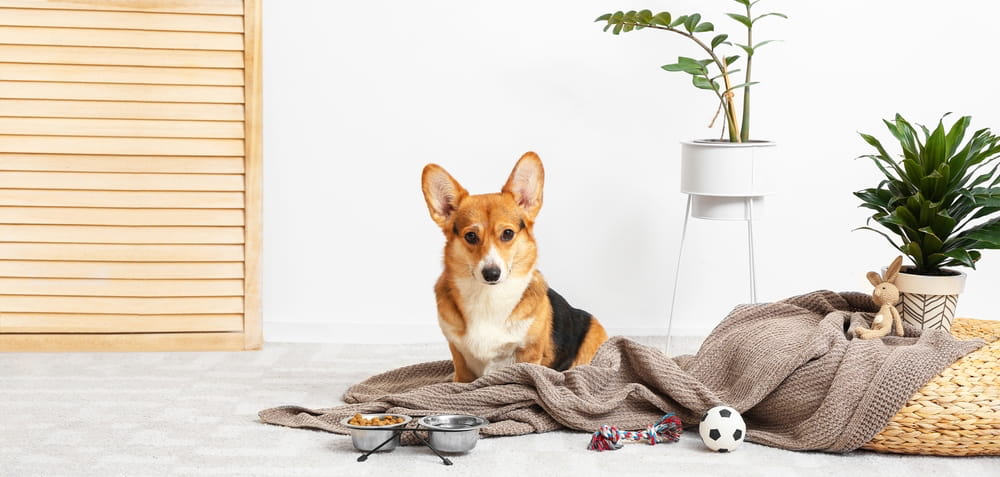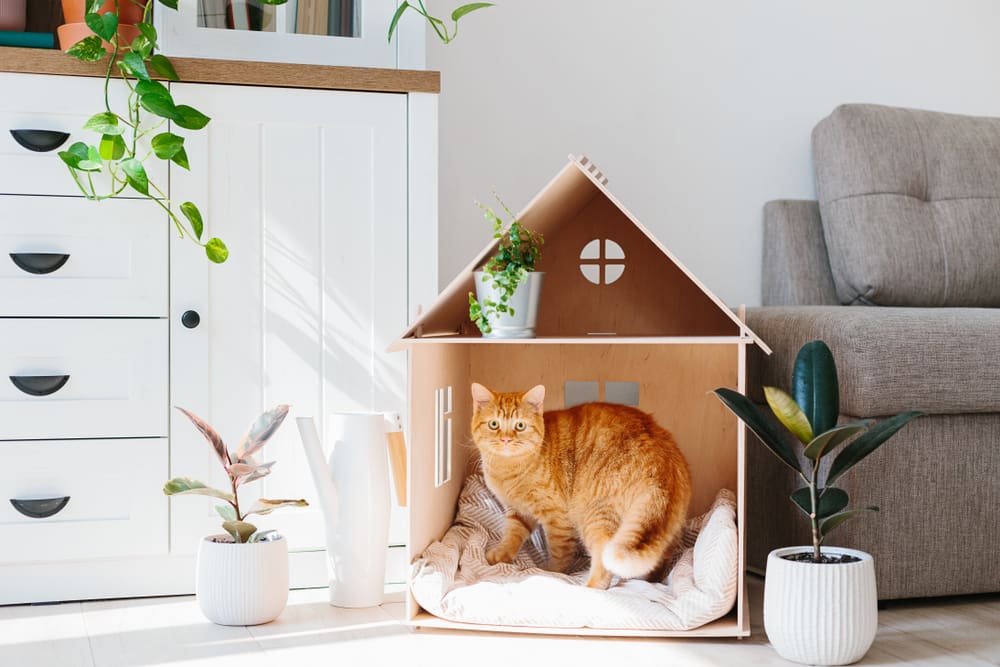Whether you’re moving with your pets or have just adopted, creating a pet-friendly home can be tricky—especially because pet-proofing doesn’t have one set of rules. To create a pet-centric home, start by asking yourself these questions:
- What types of pets do you have, and does their breed need extra considerations?
- What’s the size and height of your indoor pet?
- What’s their personality?
- Does your pet exhibit common behaviors like jumping, climbing, or scratching?
Making your home safe for pets can keep your pal comfortable in a new environment—in addition to protecting your belongings. Check out this guide to pet-proofing your home!
How to Pet-Proof Your Bedroom
Your bedroom is a safe space to relax and sleep—but that might not be true for your pets. Bedrooms can pose several hazards for small cats and large dogs alike, such as exposed cords and various choking hazards. When deciding how to organize your bedroom, keep these pet-proofing tips in mind:
- Make your bed to discourage digging.
- Keep nightstands, dresser drawers, and closets closed and secured.
- Properly store loose socks and undergarments to prevent choking.
- Keep jewelry, hair bands, and lip balms out of reach.
- Keep choking hazards, such as hangers and belts, off the floor.
- Avoid vapors like essential oils
- Keep your bedroom tidy and clean to prevent mothballs, as they can be toxic to pets.
- Use chew-proof cable protectors.
- Create a pet bed to keep your own space tidy.
How to Pet-Proof Your Living Room
The living room is where your family gathers to put their feet up and where pets are prone to climb around and explore. From storing breakable items to installing a pet gate, there’s plenty you can do to prep this area for a furry friend. To provide a dog-safe and cat-safe living space while keeping your furniture in good condition, try out these tips:
- Install fireplace screens to prevent unsupervised access.
- Decorate with non-toxic, pet-friendly houseplants.
- Put small toys like building blocks or puzzle pieces into pet-safe containers when not in use.
- Remove fragile decor from coffee and end tables.
- Consider using anti-scratch tape for upholstered furniture.
- Opt for vent covers to discourage your pet from blocking them.
- Place electrical cords out of reach.
- Keep reclining chairs closed when not in use.
- Use puppy training pads or waterproof carpet padding if your pet is accident prone.
How to Pet-Proof Your Laundry Room
The laundry room has no shortage of dangerous chemicals and choking hazards for pets—so it may be best to block unsupervised access to the space altogether. However, the laundry room is a favorite spot to cool off in hot summers, and a common spot to house your feline’s litter box. To keep your laundry room safe for pets, here are some suggestions:
- Store chemicals and detergent on high shelves or in pet-proof containers.
- Use child-proof latches and locks to keep supply cabinets closed.
- Keep garments out of reach to prevent rummaging or pulling.
- Store bulk items in large, sealed containers.
- Keep the doors to the dryer and washer closed at all times.
- Block small spaces and holes around your washer and dryer units to prevent pets from exploring.
- Move laundry baskets full of clothing and other garments off the floor.
- Throw away old dryer sheets and other used cleaning supplies.
How to Pet-Proof Your Kitchen
The kitchen can be especially dangerous for pets who like to sniff, explore, and nibble. Chock-full of sharp utensils and kitchen appliances, you should also be mindful of where you place ingredients, food, or medications that could be toxic to pets. Here are a few things to consider for a pet-friendly kitchen:
- Keep chairs and stools pushed in to prevent climbing.
- Install child-proof locks on ground-level cabinets.
- Install a baby gate to keep your pet away while cleaning or cooking.
- Cover gaps between kitchen appliances for small puppies and kittens.
- Use latched containers to store food.
- Store sharp utensils in out-of-reach drawers.
- Remove foods toxic to pets like chocolate or coffee from countertops.
- Put up a stove guard to protect pets against burns.
- Dispose of food waste and garbage in a pet-safe trash can.
How to Pet-Proof Your Bathroom
No matter where you go, your furry best friend always seems to follow. That includes the bathroom, which is full of common hazards from daily-use items. Curious cats and dogs may look through trash cans, unroll toilet paper, or worse—discover toilet water. However, there are several tips you can follow to keep your bathroom safe for pets:
- Keep trash cans out of reach or use pet-safe containers like locking trash cans.
- Store electronics like curling irons in drawers or cabinets.
- Keep medicine and cleaning supplies somewhere out of reach—if not in a medicine cabinet, in a securable container or behind cabinet doors.
- Put away toiletries like sponges and loofahs when not in use.
- Apply a taste deterrent to cabinet doors to keep prying pets out.
- Keep the toilet lid closed at all times and use a seat lock for extra security.
- Consider a cover or dust-free roll protector for toilet paper.
- Add non-slip pads to your rugs.
How to Pet-Proof Your Garage
From loose screws and power tools, to chemicals and more—the garage is full of dangers for pets. Indoor pets should be carefully supervised when in this area, and hazards should be extra secured for outdoor pets who frequent this area more often. Your home garage can be a safe place for your best friend by following proper pet safety guidelines:
- Make sure the garage is properly ventilated.
- Keep the garage door shut while your pet is present.
- Keep wrenches, saws, and more in lockable toolboxes when not in use.
- Store harmful liquids like antifreeze, gasoline, and motor oil out of reach.
- Regularly sweep or use magnets to pick up nails, screws, shavings, and other small debris from the ground.
- Add a “soft area” with a bed and water for your pet to relax outside of direct sunlight.
- Hide wiring with tape or a cord cover.
- Remove mouse and insect traps.
How to Pet-Proof Your Yard
The yard may be where your pet loves to play and explore most of all. With that in mind, you should keep the area secure, clear of hazardous lawn equipment, and ensure outdoor amenities that could pose a risk are inaccessible. To keep this top pet play area safe, utilize these pet-proofing tips for your home yard:
- Put away all lawn equipment and gardening tools when not in use.
- Double-check all your landscaping plants are pet-safe and non-toxic.
- Ensure your fence is an appropriate height and in good shape—with no footholds to grasp and all holes close to the ground covered.
- Block access to high steps, balconies, and window wells to prevent dangerous falls.
- Put up a gate to dog-proof your garden.
- Section off electrical boxes, HVAC units, and swimming pools.
- Use a pool cover to keep pets away from water.
- Use pet-friendly lawn chemicals and non-toxic pest control products.
- Pick up pet waste regularly.
- Choose a pet-friendly ground cover for fun frolicking.
***
Need short-term storage while preparing your home for a pet? With over 2,000 storage facilities across the U.S., Extra Space Storage can help. Find self storage near you!



